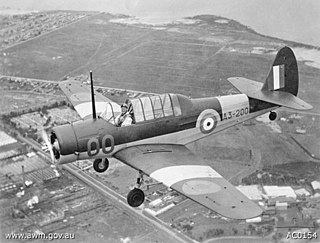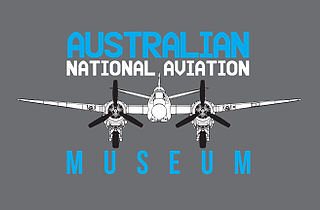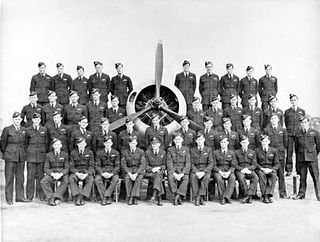
The Aermacchi or Macchi MB-326 is a light military jet trainer designed in Italy. Originally conceived as a two-seat trainer, there have also been single and two-seat light attack versions produced. It is one of the most commercially successful aircraft of its type, being bought by more than 10 countries and produced under licence in Australia, Brazil and South Africa. It set many category records, including an altitude record of 56,807 ft on 18 March 1966. More than 800 MB-326s were constructed between 1961–1975.

The CAC Boomerang is a fighter aircraft designed and manufactured in Australia by the Commonwealth Aircraft Corporation between 1942 and 1945. Approved for production shortly following the Empire of Japan's entry into the Second World War, the Boomerang was rapidly designed as to meet the urgent demands for fighter aircraft to equip the Royal Australian Air Force (RAAF). It was the first combat aircraft designed and constructed in Australia.

The Lockheed Hudson is a light bomber and coastal reconnaissance aircraft built by the American Lockheed Aircraft Corporation. It was initially put into service by the Royal Air Force shortly before the outbreak of the Second World War and primarily operated by it thereafter. The Hudson was a military conversion of the Model 14 Super Electra airliner, and was the first significant aircraft construction contract for Lockheed — the initial RAF order for 200 Hudsons far surpassed any previous order the company had received.

The Pilatus PC-9 is a single-engine, low-wing tandem-seat turboprop training aircraft manufactured by Pilatus Aircraft of Switzerland. Designed as a more powerful evolution of the Pilatus PC-7, the PC-9's first flight was made in May 1984 after which certification was achieved in September 1985. After this, the first production orders for the type were received from the Royal Saudi Air Force, with deliveries commencing in 1985. Since then, more than 250 airframes have been produced across five different variants and the type is employed by a number of military and civilian operators around the world, including the Swiss Air Force, the Croatian Air Force, and the Royal Thai Air Force.

The Pacific Aerospace Corporation CT/4 Airtrainer series is an all-metal-construction, single-engine, two-place with side-by-side seating, fully aerobatic, piston-engined, basic training aircraft manufactured in Hamilton, New Zealand.

RAAF Base Wagga is a Royal Australian Air Force (RAAF) military air base located 5.8 nautical miles southeast of the town of Wagga Wagga, in the suburb of Forest Hill, New South Wales, Australia.

The CAC Wirraway was a training and general purpose military aircraft manufactured in Australia by the Commonwealth Aircraft Corporation (CAC) between 1939 and 1946. It was an Australian development of the North American NA-16 training aircraft. The Wirraway has been credited as being the foundation of Australian aircraft manufacturing.

The CAC Wackett Trainer was the first aircraft type designed in-house by the Commonwealth Aircraft Corporation of Australia. The name was derived from its designer Lawrence Wackett. "In acknowledgement of the CAC Manager's enormous contribution, the RAAF were to call the aircraft the Wackett Trainer"

The CAC Woomera, also known as the CAC CA-4 and CAC CA-11, was an Australian bomber aircraft that was designed and constructed by the Commonwealth Aircraft Corporation during World War II. The order for the Woomera was cancelled before it became operational with the Royal Australian Air Force (RAAF).

The Moorabbin Air Museum is an aviation museum at Moorabbin Airport in Melbourne, Victoria, Australia. It was founded in 1962 as the Australian Aircraft Restoration Group, in an attempt to maintain a World War II-era Bristol Beaufighter aircraft. It has since become a museum, with a large aircraft collection. It was known as the Australian National Aviation Museum up until October 2021. As of 2021 it held nearly 60 aircraft and 25 engines.

RAAF Museum is the official museum of the Royal Australian Air Force, the second oldest air force in the world, located at RAAF Williams Point Cook, Victoria, Australia which is the oldest continuously operating Military Air Base in the world. The museum displays aircraft of significance to the RAAF from its inception as the Australian Flying Corps to the present. At the direction of Air Marshal Sir George Jones, the RAAF Museum was formed in 1952 and fell under the administration of Headquarters Point Cook until 1988 when it became a separate unit of the RAAF. It is currently overseen by the force's Air Training Wing.

No. 5 Operational Training Unit was an operational training unit (OTU) of the Royal Australian Air Force. It was formed at Wagga Wagga, New South Wales, in October 1942 to train pilots and navigators for service in World War II. The unit was initially equipped with Bristol Beauforts and Beaufighters, and later received Douglas Bostons and de Havilland Mosquitos, among other types. No. 5 OTU was transferred to Tocumwal in October 1943, and then to Williamtown in mid-1944. It was reorganised as a fighter conversion unit flying P-51 Mustangs and CAC Wirraways in February 1946, and disbanded in July 1947.
The Yeoman Cropmaster was an Australian agricultural aircraft developed from the CAC Wackett trainer of World War II.

The CAC Sabre, sometimes known as the Avon Sabre or CA-27, is an Australian variant of the North American Aviation F-86F Sabre fighter aircraft. The F-86F was redesigned and built by the Commonwealth Aircraft Corporation (CAC). Equipping five RAAF squadrons, the type saw action in the Malayan Emergency in the late 1950s, and was employed for air defence in Malaysia and Thailand in the 1960s. Ex-RAAF models also saw service with the Royal Malaysian Air Force and the Indonesian Air Force.
The AAC Wamira was a turboprop military trainer aircraft, designed for the Royal Australian Air Force (RAAF) by the Australian Aircraft Consortium (AAC). The project was cancelled shortly before the first prototype was completed.

No. 5 Service Flying Training School was a Royal Australian Air Force (RAAF) flight training unit that operated during World War II. It was one of eight Service Flying Training Schools established by the RAAF to provide intermediate and advanced flying instruction to new pilots as part of Australia's contribution to the Empire Air Training Scheme. No. 5 SFTS was formed at RAAF Station Uranquinty, New South Wales, in October 1941, and disbanded in February 1946. Its staff and equipment were employed to re-establish No. 1 Flying Training School, which transferred to RAAF Station Point Cook, Victoria, the following year. Care and Maintenance Unit Uranquinty was also formed from No. 5 SFTS's facilities, to look after surplus aircraft at the base prior to their disposal, and disbanded in December 1948.

No. 1 Flying Training School is a school of the Royal Australian Air Force (RAAF). It is one of the Air Force's original units, dating back to the service's formation in 1921, when it was established at RAAF Point Cook, Victoria. By the early 1930s, the school comprised training, fighter, and seaplane components. It was re-formed several times in the ensuing years, initially as No. 1 Service Flying Training School in 1940, under the wartime Empire Air Training Scheme. After graduating nearly 3,000 pilots, No. 1 SFTS was disbanded in late 1944, when there was no further requirement to train Australian aircrew for service in Europe.

No. 1 Basic Flying Training School was a flying training school of the Royal Australian Air Force (RAAF). Along with No. 1 Initial Flying Training School, it was formed in response to increased demand for aircrew during the Korean War and Malayan Emergency. No. 1 BFTS was established in December 1951 at RAAF Base Uranquinty, New South Wales, where it operated de Havilland Tiger Moths and CAC Wirraways. The school absorbed the activities of No. 1 IFTS in January 1955, as aircrew training requirements had eased following the end of the Korean War. No. 1 BFTS moved to RAAF Base Point Cook, Victoria, in May 1958, by which time it was exclusively flying CAC Winjeels. Its training program expanded in the mid-1960s owing to Australia's commitments in the Vietnam War. No. 1 BFTS was re-formed as No. 1 Flying Training School at Point Cook in January 1969.

Fighter World is an Australian not-for-profit aviation heritage centre at RAAF Base Williamtown, north of Newcastle, New South Wales. It is part of RAAF Aviation and Heritage and is operated with the purpose of preserving the history of fighter operations of the RAAF. The museum's collection are predominantly fighter aircraft once operated by the RAAF. Included in the collection are historically significant aircraft including de Havilland Vampire A79-1 and Dassault Mirage IIIO A3-3, both of which were the first aircraft of their type built in Australia.

The CAC Mustang is an Australian variant of the North American P-51 Mustang. It was built under license by Commonwealth Aircraft Corporation in the final stages of World War II, and though it was too late to see combat, it did participate in the Occupation of Japan after VJ-Day.






















